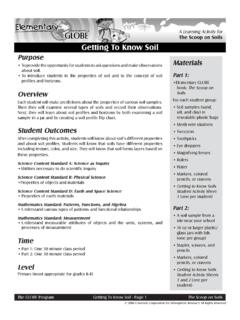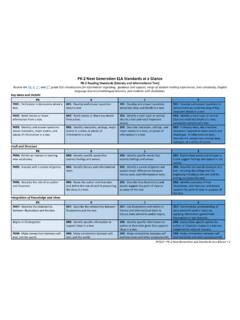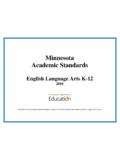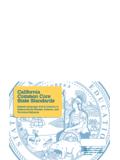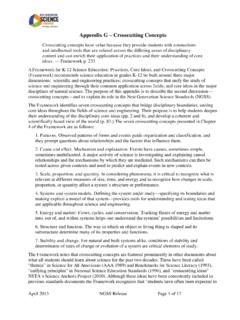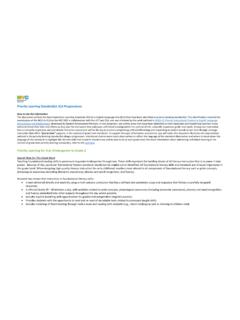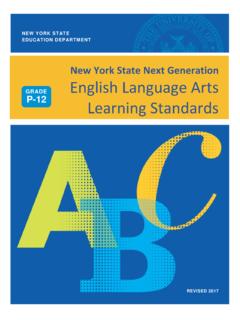Transcription of Topic Arrangements of the Next Generation Science Standards
1 Topic Arrangements of the next Generation Science Standards At the beginning of the NGSS development process, in order to eliminate potential redundancy, seek an appropriate grain size, and seek natural connections among the Disciplinary Core Ideas (DCIs) identified within the Framework for K-12 Science Education, the writers arranged the DCIs into topics around which to develop the Standards . This structure provided the original basis of the Standards , and is preferred by many states. However, the coding structure of individual performance expectations reflects the DCI arrangement in the Framework. Due to the fact that the NGSS progress toward end-of-high school core ideas, the Standards may be rearranged in any order within a grade level.
2 Table of Contents Elementary Introduction .. 3 Kindergarten Storyline .. 4 and Interactions: Pushes and Pulls .. 5 Relationships in Ecosystems: Animals, Plants, and Their Environment .. 6 and Climate .. 7 First Grade Storyline .. 8 : Light and Sound .. 9 , Function, and Information Processing .. 10 Systems: Patterns and Cycles .. 11 Second Grade Storyline .. 12 and Properties of Matter .. 13 Relationships in Ecosystems .. 14 s Systems: Processes that Shape the Earth .. 15 Design .. 16 Third Grade Storyline .. 17 and Interactions .. 18 Relationships in Ecosystems .. 19 and Variation of Traits: Life Cycles and Traits .. 20 and Climate .. 21 Fourth Grade Storyline.
3 22 .. 23 : Waves and Information .. 24 , Function, and Information Processing .. 25 s Systems: Processes that Shape the Earth .. 26 Fifth Grade Storyline .. 27 and Properties of Matter .. 28 and Energy in Organisms and Ecosystems .. 29 s Systems .. 30 Systems: Stars and the Solar System .. 31 Design .. 32 Middle School Physical Sciences Storyline .. 33 Middle School Life Sciences Storyline .. 35 Middle School Earth and Space Sciences Storyline .. 37 Middle School Engineering Design Storyline .. 39 and Properties of Matter .. 40 Reactions .. 42 and Interactions .. 43 .. 45 September 2017 2013 Achieve, Inc. All rights of 102 and Electromagnetic Radiation.
4 47 , Function, and Information 48 and Energy in Organisms and Ecosystems .. 50 Relationships in Ecosystems .. 52 , Development, and Reproduction of Organisms .. 53 Selection and Adaptations .. 55 Systems .. 57 of Earth .. 58 s Systems .. 59 and Climate .. 60 Impacts .. 61 Design .. 63 High School Physical Sciences Storyline .. 65 High School Life Sciences Storyline .. 68 High School Earth and Space Sciences Storyline .. 70 High School Engineering Design Storyline .. 73 and Properties of Matter .. 74 Reactions .. 76 and Interactions .. 78 .. 80 and Electromagnetic Radiation .. 82 and Function .. 84 and Energy in Organisms and Ecosystems.
5 85 Relationships in Ecosystems .. 87 and Variation of 89 Selection and Evolution .. 91 Systems .. 93 of Earth .. 95 s Systems .. 97 and Climate .. 99 Sustainability .. 100 Design .. 102 September 2017 2013 Achieve, Inc. All rights of 102 Elementary Standards Students in kindergarten through fifth grade begin to develop an understanding of the four disciplinary core ideas: physical sciences; life sciences; earth and space sciences; and engineering, technology, and applications of Science . In the earlier grades, students begin by recognizing patterns and formulating answers to questions about the world around them. By the end of fifth grade, students are able to demonstrate grade-appropriate proficiency in gathering, describing, and using information about the natural and designed world(s).
6 The performance expectations in elementary school grade bands develop ideas and skills that will allow students to explain more complex phenomena in the four disciplines as they progress to middle school and high school. While the performance expectations shown in kindergarten through fifth grade couple particular practices with specific disciplinary core ideas, instructional decisions should include use of many practices that lead to the performance expectations. September 2017 2013 Achieve, Inc. All rights of 102 Kindergarten The performance expectations in kindergarten help students formulate answers to questions such as: What happens if you push or pull an object harder?
7 Where do animals live and why do they live there? What is the weather like today and how is it different from yesterday? Kindergarten performance expectations include PS2, PS3, LS1, ESS2, ESS3, and ETS1 Disciplinary Core Ideas from the NRC Framework. Students are expected to develop understanding of patterns and variations in local weather and the purpose of weather forecasting to prepare for, and respond to, severe weather. Students are able to apply an understanding of the effects of different strengths or different directions of pushes and pulls on the motion of an object to analyze a design solution. Students are also expected to develop understanding of what plants and animals (including humans) need to survive and the relationship between their needs and where they live.
8 The crosscutting concepts of patterns; cause and effect; systems and system models; interdependence of Science , engineering, and technology; and influence of engineering, technology, and Science on society and the natural world are called out as organizing concepts for these disciplinary core ideas. In the kindergarten performance expectations, students are expected to demonstrate grade-appropriate proficiency in asking questions, developing and using models, planning and carrying out investigations, analyzing and interpreting data, designing solutions, engaging in argument from evidence, and obtaining, evaluating, and communicating information. Students are expected to use these practices to demonstrate understanding of the core ideas.
9 September 2017 2013 Achieve, Inc. All rights of and Interactions: Pushes and Pulls*The performance expectations marked with an asterisk integrate traditional Science content with engineering through a Practice or Disciplinary Core section entitled Disciplinary Core Ideas is reproduced verbatim from A Framework for K-12 Science Education: Practices, Cross-Cutting Concepts, and Core Ideas. Integrated and reprinted with permission from the National Academy of and Interactions: Pushes and PullsStudents who demonstrate understanding can: K-PS2-1. Plan and conduct an investigation to compare the effects of different strengths or different directions of pushesand pulls on the motion of an object.
10 [Clarification Statement: Examples of pushes or pulls could include a string attached to an object being pulled,a person pushing an object, a person stopping a rolling ball, and two objects colliding and pushing on each other.] [Assessment Boundary: Assessment is limited to different relative strengths or different directions, but not both at the same time. Assessment does not include non-contact pushes or pulls such as those produced by magnets.]K-PS2-2. Analyze data to determine if a design solution works as intended to change the speed or direction of an objectwith a push or a pull.* [Clarification Statement: Examples of problems requiring a solution could include having a marble or other object move a certaindistance, follow a particular path, and knock down other objects.]





